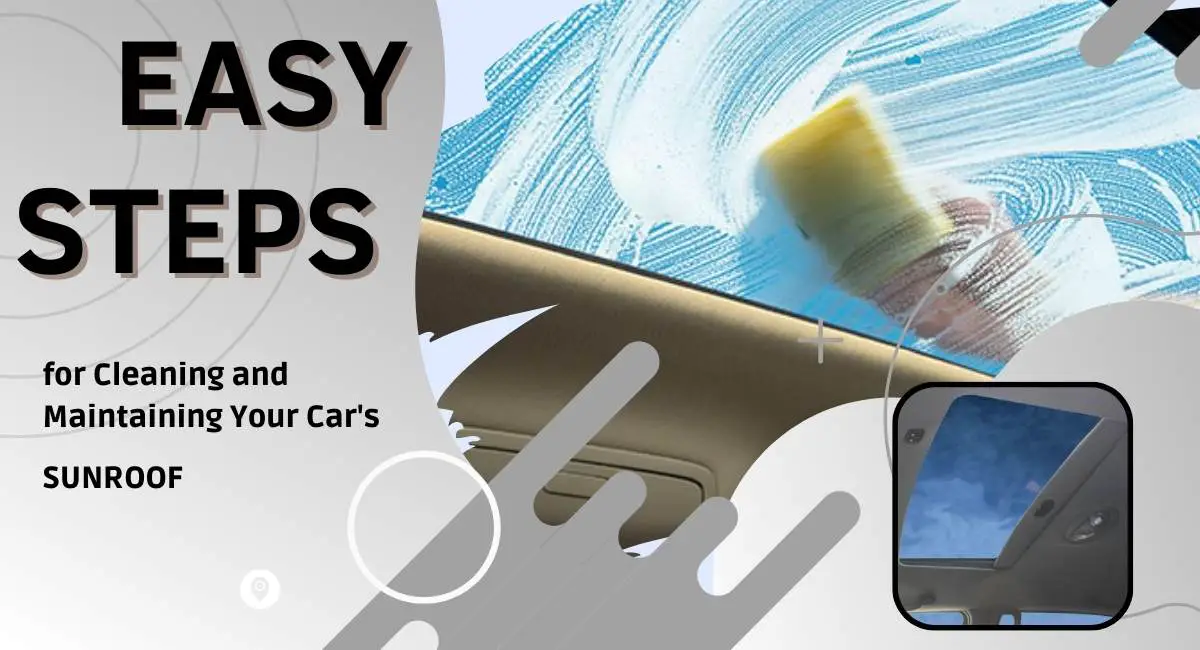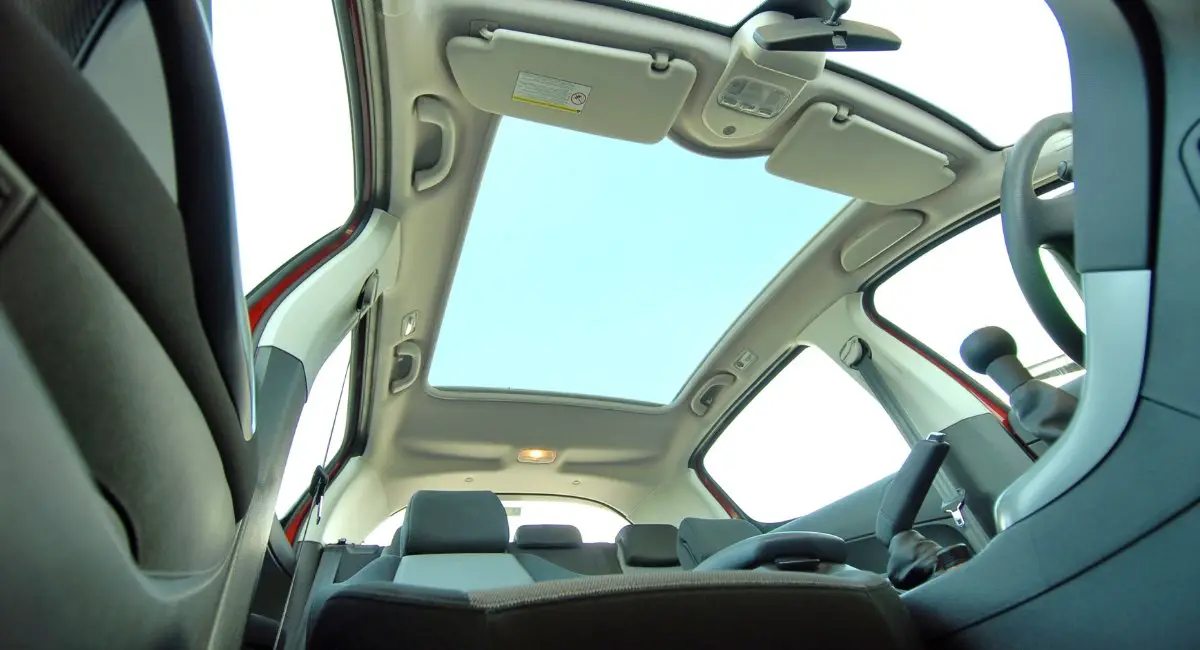Car sunroofs are increasingly becoming popular. They provide a panoramic view of the sky and enhance the driving experience. With a sunroof, you’ll enjoy more light space. So, there’s continuously a demand for the sunroof.
To put this into perspective, the predicted Compound Annual Growth Rate(CAGR) of the automotive sunroof market by FMI is 11% from 2023 to 2033. It is about US$ 21.09 billion. And the market is continuously growing.
However, to ensure that this delightful feature continues to bring joy to your rides, giving it the care and attention it deserves is vital. A neglected sunroof is an open door to leaks, malfunctions, and reduced lifespan.
The rest of this article gives manageable steps for cleaning and maintaining your car’s sunroof. The types of sunroofs and tips for troubleshooting highlight the importance of regular upkeep.
Before we proceed, let’s familiarize ourselves with the different types of car sunroofs.
Types of Car Sunroofs
There are various types of car sunroofs, as you’ll see below. These varieties determine how you’ll maintain your sunroof—some are high quality, and others are not.
Inbuilt Sunroof/Moonroof
Integrated sunroofs blend into the vehicle’s headroom and are easily operated with a simple touch of a button since they have a sliding glass panel fitting. This type allows for easy ventilation during long drives, creating a spacious and open feel within the car.
Solar Sunroof
Scientifically advanced solar sunroofs feature solar panels with photovoltaic cells attached to the roof. This innovative technology generates electricity from sunlight, making it eco-friendly and powering car batteries. Harnessing natural sunlight contributes to fuel cost savings.
Panoramic Sunroof
Panoramic sunroofs offer an expansive sky view, enhancing the driving experience and covering a large portion of the roof. Comprising multiple panels with sections you can open, they provide an open-air feel and added flexibility for occupants.
Pop-up Sunroof
A budget-friendly option, pop-up sunroofs are manually operated and easily adjustable. Installed as post-market products, they offer good ventilation, allowing ample light and fresh air into the car. Their simplicity makes them suitable for various car designs.
Tilt-And-Slide Sunroof
Like inbuilt sunroofs, the spoiler, also called the tilt-and-slide variant, tilts and slides open above the car’s roof, enhancing aerodynamics and adding a sporty aesthetic. Electronically operated, this sunroof type offers convenience and style.
Rag-top Sunroof
Also known as a folding or soft-top sunroof, this design utilizes materials like leather and vinyl. Originating in Europe and the US, it can be operated manually or electronically, with the roof folding down on the car’s rear side when opened.
Top-mount Sliding Sunroof
Popular in Europe, rail mount slider sunroofs consist of glass panels and open parallel to the car’s roof. The rail mounted on top ensures no loss of headroom, making it a favorable choice for sunroof enthusiasts.
Targa/T-Top Sunroofs
Targa top sunroofs feature removable panels that open towards the car’s sides, with a long metal strip running across the length. Some versions have non-removable panels made of glass or plexiglass, providing a unique view of the car’s sides and often found in iconic car models.

How to Clean Your Car’s Sunroof
To embark on your sunroof maintenance journey, gather the essential supplies as listed below:
- Microfiber cloth,
- glass cleaner,
- sunroof seal lubricant,
- soft-bristle brush,
- compressed air canister,
- water,
- mild soap solution, and
- a screwdriver (if needed for removal)
The materials listed are readily available and affordable, making sunroof maintenance cost-effective.
Now, let’s do the actual cleaning—the exterior and interior cleaning.
Exterior Cleaning
A car’s sunroof exterior comprises a frame, seals, glass panel, track and rails, motor and mechanism, drainage channels, sunshade, and wind deflector. Besides cleaning your car’s sunroof for aesthetics, you must keep its exterior clean to ensure longevity.
The following steps will guide you through:
Remove Loose Dirt and Debris
Start by taking a soft-bristle brush to sweep away leaves, dust, and other debris that may have accumulated on the exterior of your sunroof.
While a soft bristle can remove dirt, you’ll need a more sophisticated way to clean stuck debris. A canister of compressed air proves invaluable for stubborn debris lodged in crevices. According to industry experts, compressed air clears out trapped dirt effectively, ensuring your sunroof’s exterior is pristine.
Wash the Exterior Surface
Make a mixture of water and mild soap to gently wash the sunroof’s exterior. The combination of water and soap is practical and gentle enough to preserve the integrity of the sunroof’s materials.
Proper cleaning can extend the lifespan of sunroof components to a certain percentage, making it a worthwhile investment of your time.
Employ a microfiber cloth to eliminate dirt, and rinse with clear water to unveil a gleaming sunroof. This simple step not only enhances the aesthetics of your car but also contributes to the overall longevity of your sunroof.
Interior Cleaning
It’s now time to check out your sunroof interiors. So, try the following:
Clear Interior Debris
Moving to the interior, it’s essential to eliminate dust and debris that may have accumulated in the sunroof’s channels. Car maintenance professionals often link interior debris as a leading cause of sunroof malfunctions. Use compressed air to blow away dust and vacuum any remaining particles.
Clean Interior Surfaces
Wipe down the interior components of your sunroof with a microfiber cloth. For the glass panel, use a quality glass cleaner. A well-maintained interior ensures smooth sunroof operation and provides a comfortable and enjoyable driving experience.
Ways to Maintain Your Car’s Sunroof
After cleaning your sunroof, maintaining it will contribute to its longevity and trouble-free operation. Here are essential ways to maintain your sunroof:
1. Lubricate Sunroof Seals
One often overlooked aspect of sunroof maintenance is lubricating the seals. Sunroof seal lubricant maintains the flexibility of the seals, preventing them from drying out and cracking. This step is particularly crucial in regions with extreme weather conditions. Statistics indicate that cars exposed to harsh climates are more prone to sunroof seal damage, making regular lubrication a preventative measure.
2. Check Drainage Channels
A common issue with sunroofs is clogged drainage channels. Regular inspection and cleaning of these channels can avert water buildup, reducing the possibility of leaks and water damage to your car’s interior.
Ensure water can flow smoothly through the channels using compressed air or a gentle stream to clear clogs. This proactive measure prevents potential damage and contributes to a hassle-free driving experience.
3. Check and Replace Sunroof Seals
Have you recently seen signs of wear, damage, or deterioration? These conditions can compromise the integrity of the seal and lead to various issues. Over time, exposure to sunlight, temperature fluctuations, and environmental elements can cause rubber seals to become brittle, cracked, or lose their elasticity.
Damaged or worn seals may result in water leaks, wind noise, and reduced insulation, affecting the overall performance of the sunroof. Therefore, replacing sunroof seals is advisable when you notice visible signs of deterioration or during routine maintenance inspections.
Timely replacement ensures a watertight and airtight seal, preventing potential damage to the vehicle’s interior and maintaining the optimal functionality of the sunroof. Regularly inspecting and replacing sunroof seals as part of your vehicle maintenance routine can provide a comfortable and enjoyable driving experience.
4. Test Operation
To ensure the continued free operation of your sunroof, regularly test its opening and closing mechanisms. It will help you find and address potential problems before they escalate.
During your testing, pay close attention to the sealing of the sunroof when closed. Water leaks resulting from improperly sealed sunroofs commonly cause interior damage. Promptly addressing any issues with the seal can prevent costly repairs.
5. Address Issues Promptly
If you encounter any problems during your testing, feel free to address them promptly. Waiting to fix sunroof issues can lead to more extensive damage and higher repair costs.
According to the June 2023 consumer price index, motor vehicle repair prices have roughly a 20% increase over the past year. Whether it is the sunroof repair or any other part, you don’t want to fork over a little more on repairs.
6. Sunshade Maintenance
If your sunroof has a sunshade, handle it carefully to prevent tears or damage. Maintain it clean by using a soft brush or vacuum. Address any issues promptly to ensure proper functionality.
While not directly related to the sunroof’s mechanical components, the sunshade plays a role in the overall experience. A clean sunshade fabric enhances the appearance of your car’s interior and contributes to a pleasant driving atmosphere. Use a soft brush or vacuum to make the sunshade clean regularly.
Other tips for maintaining your car’s sunroof include:
Avoid Forceful Closing: When closing the sunroof, avoid using excessive force. Gently guide it to ensure proper alignment and prevent damage to the seals and tracks.
Use Caution in Extreme Conditions: Exercise caution when operating the sunroof in extreme weather conditions, such as heavy rain, snow, or freezing temperatures. It can help prevent potential issues related to weather exposure.
Keep Glass Clean: Regularly clean the glass panel with a suitable glass cleaner to maintain visibility and avert the accumulation of dirt or residue.
Store Properly: If you intend to park your car for an extended time, consider closing the sunroof to shield it from the elements and minimize the chance of debris accumulating.
Regular Inspection Schedule
To maintain your sunroof’s optimal performance, establish a regular inspection schedule. Depending on usage and environmental conditions, quarterly checks or more frequent inspections can catch potential issues before they escalate.
Incorporate sunroof cleaning and checks into your overall car maintenance routine. Regular attention to your sunroof ensures its longevity and contributes to your vehicle’s resale value. According to automotive market trends, well-maintained features, such as sunroofs, positively influence a car’s resale value.

Tips for Troubleshooting Sunroof Problems
It’s about to start raining, and you’re trying to close the sunroof, and it’s stuck. So, what should you do? Troubleshooting common sunroof problems can help you address such issues and ensure smooth functionality.
Most of these tips are discussed above, so when you clean and maintain your car’s sunroof, you’ll rarely face problems.
However, here are some of the tips:
Check for Debris: Examine the sunroof tracks and seals for debris or obstructions hindering movement.
Verify Seals: Inspect the rubber seals for wear or damage, as compromised seals can lead to leaks. Replace if necessary.
Test the Switch: Ensure the sunroof switch is functioning correctly. If not, it might indicate an electrical issue or a faulty switch.
Examine Fuse and Wiring: Check the sunroof fuse and wiring for any signs of damage. A blown fuse or faulty wiring can disrupt the sunroof’s operation.
Inspect Drainage Channels: Clogged drainage channels can lead to leaks—clear debris using compressed air or a small tool to ensure proper drainage.
Lubricate Moving Parts: Apply an appropriate lubricant to moving parts, such as tracks and hinges, to prevent friction and enhance smooth operation.
Test Sunroof Motor: Listen for unusual noises when operating the sunroof. Strange sounds may indicate a malfunctioning motor that needs attention.
Check Alignment: Verify that the sunroof is aligned correctly. Misalignment can lead to leaks and operational issues.
Inspect Sunshade: If your sunroof has a sunshade, check for any obstructions or damage that might affect its operation.
Look for Visible Damage: Inspect the glass panel for cracks or chips. Any visible damage may compromise the integrity of the sunroof.
Verify Water Flow: Pour a small amount of water into the sunroof channels when they’re open. Ensure the water flows freely through the drainage channels and exits the vehicle without pooling inside.
Consult the Owner’s Manual: Review your car’s manual for specific troubleshooting tips and guidelines provided by the manufacturer.
If these troubleshooting tips don’t resolve the issue, you should ask for professional assistance from a qualified mechanic or a dealership service center. Sunroofs are delicate and may cause more damage if you fail to handle them professionally.
Conclusion
Taking easy steps to clean and maintain your car’s sunroof is a small investment with significant returns. Statistics and facts highlight the financial and safety benefits of regular upkeep. By following this comprehensive guide, you not only enhance the longevity and performance of your sunroof but also contribute to a more enjoyable and worry-free driving experience. So, grab your supplies, show your sunroof some love, and let it shine bright on your journeys ahead.
